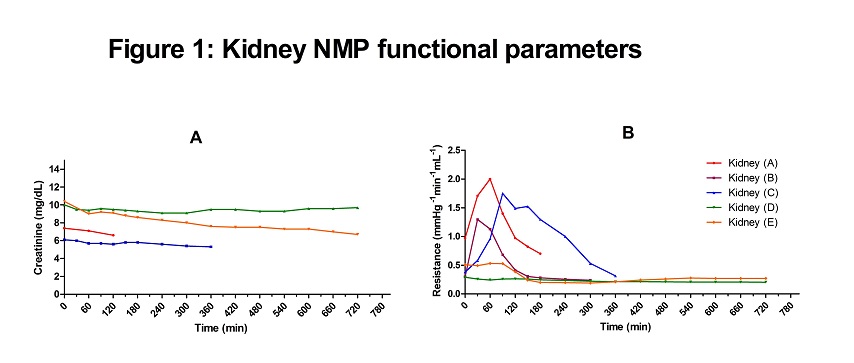Extended Ex Vivo Kidney Perfusion Using Hemopure as an Oxygen Carrier: A Method to Preserve, Assess and Repair Discarded Organs.
Transplant Surgery, Massachusetts General Hospital, Harvard Medical School, Boston, MA
Meeting: 2017 American Transplant Congress
Abstract number: B120
Keywords: Cadaveric organs, Kidney transplantation, Machine preservation, Preservation solutions
Session Information
Session Name: Poster Session B: Ischemic Injury and Organ Preservation Session II
Session Type: Poster Session
Date: Sunday, April 30, 2017
Session Time: 6:00pm-7:00pm
 Presentation Time: 6:00pm-7:00pm
Presentation Time: 6:00pm-7:00pm
Location: Hall D1
Background: Hypothermic non-oxygenated machine perfusion (HMP) is commonly used in kidney preservation, providing some advantage over static cold storage, as well as flow and resistance numbers that help in determining suitability for transplantation. However, the low temperature offers little opportunity to improve organ quality or functional data. We therefore established an oxygenated normothermic machine perfusion (NMP) system to investigate the possibility of rescuing kidneys from the 2500 a year currently discarded.
Methods: Pressure and temperature controlled NMP with Hemopure (bovine hemoglobin-based oxygen carrier) was used to perfuse 5 human kidneys deemed untransplantable by all transplant centers. 4 were DCD (A, B, C, D) and 1 DBD (E). Kidneys A, B, C, D, and E were perfused for 3, 5, 6, 12 and 12 hours respectively. Perfusate creatinine, flow/resistance, and urine production were measured.
Results: Average CIT was 21h. A was declined for poor flush, B, D, and E for percent glomerulosclerosis (GS%) 15, 24, and 30% in combination with flow (ml/min/100g)/resistance (ml/min/100g) on HMP of 80/0.45, 110/0.26, and 76/0.46, and C for hilar hematoma. Perfusate creatinine (fig. 1a), and renal artery resistance (fig. 1b) over time are shown below. Kidneys A, B and E made a total of 18.5, 7.8, and 80 ml of urine, respectively. 
Conclusions: Our NMP study is hampered by the long CIT likely impairing our ability to rescue theset discarded kidneys, but our results are notable especially for urine production and declining perfusate creatinine in 3/5 discarded kidneys, and decrease in arterial resistance after an initial spike, nadiring at 3-6 hours. We are currently testing tissue samples for ATP content to evaluate the energy status at a cellular level to see if restoration of ATP content also reaches a maximum over the same time period.
CITATION INFORMATION: Fontan F, Aburawi M, Karimian N, Uygun K, Delmonico F, Yeh H, Markmann J. Extended Ex Vivo Kidney Perfusion Using Hemopure as an Oxygen Carrier: A Method to Preserve, Assess and Repair Discarded Organs. Am J Transplant. 2017;17 (suppl 3).
To cite this abstract in AMA style:
Fontan F, Aburawi M, Karimian N, Uygun K, Delmonico F, Yeh H, Markmann J. Extended Ex Vivo Kidney Perfusion Using Hemopure as an Oxygen Carrier: A Method to Preserve, Assess and Repair Discarded Organs. [abstract]. Am J Transplant. 2017; 17 (suppl 3). https://atcmeetingabstracts.com/abstract/extended-ex-vivo-kidney-perfusion-using-hemopure-as-an-oxygen-carrier-a-method-to-preserve-assess-and-repair-discarded-organs/. Accessed December 26, 2025.« Back to 2017 American Transplant Congress
